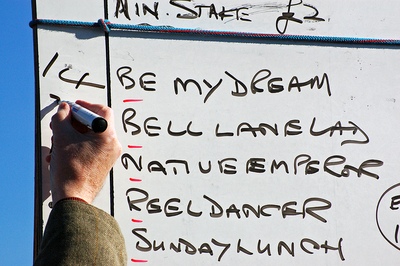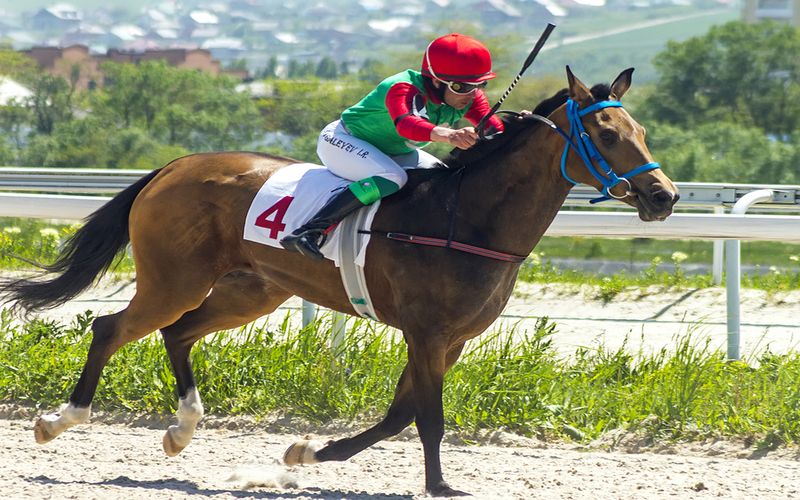The world of horse racing betting is littered with its own terminology. This is a language which soon becomes second nature to fans of the sport, but may be unfamiliar to those just dipping their toes into the racing waters.
When tuning into the latest action, one of the terms which pops up most frequently is that of “Favourite” and the related “Joint Favourite” and “Co-Favourite”. But what on earth are all those TV pundits and punters talking about? Thankfully – in common with most things in the sport – it isn’t as complicated as you may fear. Here we explain the meanings of these favourite-related terms and provide examples of each phrase in action.
Favourites
 Also commonly known as the “Jolly” or “Market Leader”, and infrequently as the “Chalk” or “Sponk”, the favourite is simply the horse with the shortest betting odds ahead of any given race and, therefore – at least in theory – the runner who has the best chance of winning.
Also commonly known as the “Jolly” or “Market Leader”, and infrequently as the “Chalk” or “Sponk”, the favourite is simply the horse with the shortest betting odds ahead of any given race and, therefore – at least in theory – the runner who has the best chance of winning.
The term “Favourite” stems from the fact that the price of a horse will shorten in relation to the amount of money placed on them to win. As such, the shortest-priced runner in the field can be thought of as the favourite of the betting public, as it will most likely have attracted the largest number of bets.
The cheery-sounding “Jolly” emerged over time, with the favourite often being referred to as the “Jolly Old Favourite”. The lesser-used “Chalk” harks back to the days when bookmakers used chalk and blackboards to display their prices, with the frequency at which the odds needed to be changed on the market leader resulting in consistent bursts of chalk dust in the air. As for “Sponk”, the origins seem to lie with a group of 1940s public school boys with far too much time on their hands to make up bizarre-sounding words. Or at least that’s our take on the widely accepted theory.
Whenever you hear the term favourite in relation to a horse, it simply means that the runner in question is out on his own at the head of the betting market, as in the example below.
| Horse | Odds |
|---|---|
| Swordplay | 4/5 F |
| Straight A | 15/8 |
| Different Breed | 10/1 |
| See All Match | 20/1 |
| Without Flaw | 25/1 |
| Cogsworth | 40/1 |
| Fillide Melandroni | 66/1 |
Rather than writing the word “favourite” beside the name of the market leader, the shorthand “F” is commonly used, as in the case of Swordplay, the 4/5 favourite in the above list of odds.
Joint Favourites

Our Swordplay example shows a situation where the betting public and odds compilers have zeroed in on a single runner as the most likely winner. However, that isn’t always the case, which is where joint favourites and co-favourites emerge on the scene.
The term “Joint Favourite” simply refers to those instances where two – and only two – runners share the same price at the head of the betting, as was the case in the following 2023 race from Doncaster.
| Horse | Odds |
|---|---|
| Jack Daniel | 4/1 JF |
| Absolute Dream | 4/1 JF |
| Leadenhall | 5/1 |
| Tiger Beetle | 13/2 |
| Bird Of Prey | 7/1 |
| Cassy O | 8/1 |
| Dougies Dream | 10/1 |
| Royal Prospect | 12/1 |
| Tipperary Moon | 22/1 |
| Olympicus | 33/1 |
The short-hand notation for a horse that is a joint favourite is, as you would expect “JF”, as displayed beside the 4/1 joint favourites Jack Daniel and Absolute Dream.
Co-Favourites
Whilst the term favourite refers to a single horse at the head of the market, and joint favourite denotes exactly two runners sharing that position, there are times when the betting market struggles to settle on even two runners as the most likely winners of an event.
The phrase “Co-Favourite”, therefore, refers to those occasions when three or more runners share the status of being favourite for the race, as seen ahead of the 2023 Chipchase Stakes at Newcastle:
| Horse | Odds |
|---|---|
| Tiber Flow | 4/1 CF |
| Spycatcher | 4/1 CF |
| Brad The Brief | 4/1 CF |
| Mount Athos | 4/1 CF |
| Witch Hunter | 5/1 |
| Judicial | 12/1 |
| Iconic Moment | 20/1 |
| Prince of Pillo | 33/1 |
Consistency and common sense again prevail with the shorthand, with the various co-favourites all denoted as CF, as we see above with the 4/1 co-favourites, Tiber Flow, Spycatcher, Brad The Brief, and Mount Athos.
When looking at the betting odds in advance, the letters “CF” alone will be used to highlight the co-favourites. However, when viewing the results pages of the newspaper or online, you may see a runner instead listed as “Tiber Flow 4/1 CF4” for example. This additional “4” represents the number of runners who shared the status of co-favourite for the race, as in co-favourite of four.
Unsurprisingly, a race with only three co-favourites, would use CF3, one with five, CF5, and so on.
Second Favourites

As we have seen, the horse (or horses) at the head of the betting are referred to as the favourite, joint favourite, or co-favourite depending on the number of runners who share that status. Any race with a single market leader will also have a second favourite, which, as you might have guessed, is the runner with the second shortest odds in the betting market.
One point to note here is that races with joint or co-favourites will never have a runner listed as the second favourite due to the fact that the two most popular horses in the betting are already included in the joint or co-favourite category.
An example of a race with a clear second favourite can be seen in the event in which Swordplay was the outright favourite:
| Horse | Odds |
|---|---|
| Swordplay | 4/5 F |
| Straight A | 15/8 2F |
| Different Breed | 10/1 |
| See All Match | 20/1 |
| Without Flaw | 25/1 |
| Cogsworth | 40/1 |
| Fillide Melandroni | 66/1 |
Behind Swordplay, but well ahead of the rest, Straight A was the second favourite for this contest (and, in fact, did earn top marks by winning the race).
The shorthand for “Second Favourite” is a nice and straightforward “2F”.
Joint and Co-Second Favourites

Just as with favourites, things can become a little congested with the runners sitting just behind the market leader, resulting in joint and co-second favourites, as shown in the following example races.
| Horse | Odds |
|---|---|
| Raatea | 5/2 F |
| Lethal Levi | 11/2 J2f |
| Batal Dubai | 11/2 J2f |
| Magical Saint | 13/2 |
| Tiger Crusade | 6/1 |
| Coachello | 9/1 |
| Soldiers Minute | 9/1 |
| Aleezdancer | 10/1 |
| Animate | 11/1 |
Raatea is the clear favourite for this race at 5/2.
Just behind him, there’s nothing to split Lethal Levi and Batal Dubai, who are, therefore, deemed to be the joint second favourites, denoted by “J2F”.
| Horse | Odds |
|---|---|
| Safe Voyage | 3/1 F |
| Wobwobwob | 5/1 C2F |
| Zip | 5/1 C2F |
| Air To Air | 5/1 C2F |
| Lord Of The Lodge | 15/2 |
| The Gatekeeper | 10/1 |
| Marshal Dan | 12/1 |
| Utilis | 12/1 |
| Adeb | 12/1 |
As is the case with favourites, sometimes the status of second favourite is shared by more than two runners, as was the case in the above 2023 contest at Newcastle.
Here Safe Voyage is the clear favourite at 3/1, but behind him, Wobwobwob, Zip, and Air To Air have the same price of 5/1, and therefore become the “co-second favourites” for the race – denoted by C2F.
The type of notation used for co-favourites in the racing results carries over into the co-second favourite shorthand. Just as CF3 signifies that a runner was the co-favourite of 3, C2F3 represents co-second favourite of 3, C2F4 is co-second favourite of 4, and so on.
And that is just about all you need to know regarding joint and co-favourites. All explained with barely a Sponk in sight.
